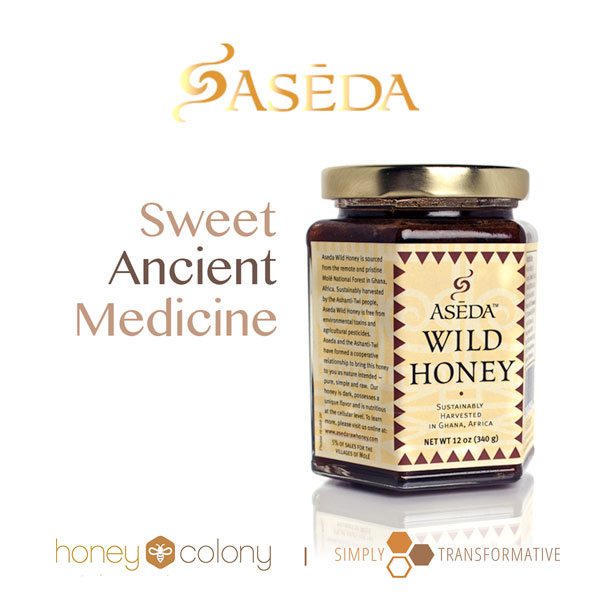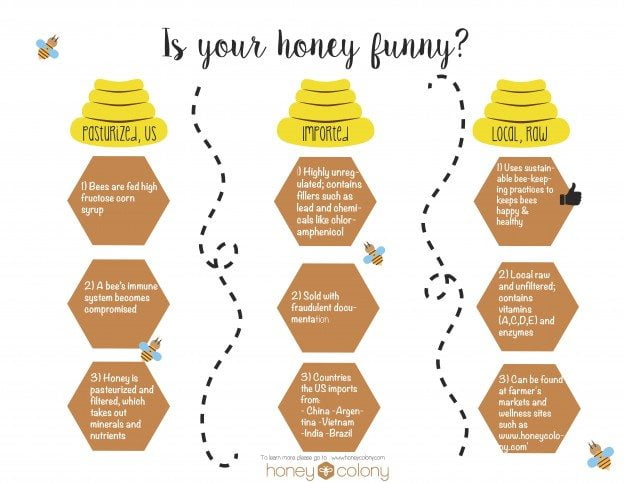You just ordered tea at a café and you ask for honey – hey, it’s healthier than cane sugar – right? Well, sadly, the majority of mass produced honey is heavily adulterated to the point where it’s questionable whether it’s any healthier than high fructose corn syrup.
What exactly is adulterated honey? Those in the bee industry call it ‘funny honey’ and here’s a few ways the nectar of the gods is cheapened to become sweet s%$t.
Sneaking in Sugar and Corn Syrup
Merchandisers are always looking to squeeze a little more cash out of a product and this precious commodity is no different; it’s been adulterated since ancient times. Back then, producers snuck in fig and date syrup into honey – which wasn’t unhealthy, just dishonest. But then in the 1970s, corn syrup and cane sugar started being thrown into the mix.
In April of 2014, the FDA ruled that any honey that was adulterated by the addition of sugar and corn syrup could not label their product as pure “honey” and rather would have to label it as a “blend” .
But think about this, the U.S. only produces 149 million pounds of honey a year but consume over 400 million pounds a year. So the majority of the honey sold in the U.S. is actually imported. And like cheap cocaine is cut with cheaper fillers.
Currently, the trace-ability of imported honey’s source is limited to the documentation each processor provides. No standardized analysis is made on such honey, which makes it easy for importers to provide fraudulent documentation and sell counterfeited and adulterated honey in the guise of “pure” honey.
Discover Real Wild Organic Honey ~ Raw and Real!
Adulterating the Bees’ Natural Process
It gets worse. Even though “pure” honey produced in the U.S. hasn’t been directly adulterated with sweeteners, the natural process bees take to make the honey has been extremely – and terrifyingly adulterated.
Beekeepers have always had to be conscious about just how much honey they have to leave for the bees to feed off of and how much they can take for human use. But ever since the 1970s, commercial beekeepers have gotten greedy. They started taking all the honey away from the honeybees and giving them high-fructose corn syrup (HFCS) to eat instead. The bees are eating junk!
HFCS weakens honeybees’ immune system and defenses. Honeybees glean not only nectar from flowers, but also pollen and propolis, which is loaded with three types of compounds which help bees detoxify their cells. These days, honeybees are already under a lot of stress with all the pesticides in their environment, systemic and not. When robbed of their honey – and thus the pollen and propolis within it – bees become much more defenseless.
And how can we expect honeybees deprived of nutrients with weak immune systems to make quality, nutrient-full honey?
According to Dr. Schreiber, a certified clinical nutritional specialist and licensed dietitian/nutritionist, the practice of feeding high fructose corn syrup to honeybees has led to certain genes not getting activated in the bees as well as weaker immune systems.
“Due to the force feeding of high fructose corn syrup, the actual honey itself is different; it is a mixture of honey and high fructose corn syrup. As consumers, we are led to believe that honey is pure honey when, in fact, two thirds of the honey produced in the United States is a mixture of honey and high fructose corn syrup. High fructose corn syrup consumption has been associated with a myriad of diseases, such as diabetes, heart disease and obesity.”
Pasteurized Vs. Raw Honey
The majority of commercial honey has been depleted of many of its many minerals and nutrients and contains very little or is totally bereft of pollen – one of the most healing, nutritious aspects of honey. This is because mainstream honey is extremely processed. Honey naturally crystallizes over a short period of time, unless stored in very cold temperatures. In order to keep honey in a liquid form for as long as possible, honey is usually heated and pasteurized. This changes honey’s chemical composition so that many of the minerals and nutrients are sucked out of it. You’re essentially eating dead food.
After the pasteurization process, honey is then ultra-filtered, which is what takes the pollen out of the honey.
What incentive do merchandisers have to rob not only the bees but us of nutrient dense pollen? Well pollen is the only verifiable detail that identifies the honey’s source. Bee pollen is a source of many important minerals and vitamins. Ultra filtering is a trick the Chinese first adopted to sell massive amounts tampered honey, some even containing illegal antibiotics, to the US market.
Raw honey, on the other hand, hasn’t been tampered with in such ways and still includes vitamins A, C, D, E, certain amino acids and high concentrations of B-complex vitamins. It also contains beneficial enzymes such as amylase, which helps us to digest starchy food such as bread. Raw honey’s antioxidant and anti-bacterial properties can also help improve the digestive system.
But Even Pure, Raw Honey Can Contain Toxic Chemicals
Unfortunately, even raw honey can be tainted – especially when it is commercially sold and sometimes even when it claims to be “locally raised”. Many of these hives are treated with miticides, insecticides which fight off the Varroa mite. These miticides leave behind residues in both the wax and in the honey. Also consider that bees can fly up to fives miles.
You Gotta Know Your Source
If you want to be sure you are eating pure, raw high-quality, nutritious honey, you really need to research exactly where your honey comes from. It’s nice to get to know your local beekeepers – or to find a company with a proven track record of providing quality, ethical honey.
 Linda Miriam Aziz-Zadeh is a freelance writer and editor who is passionate about preserving the natural beauty and wonder of our bodies, this planet, and the world. She is the cofounder of Crunchy Buzz, a digital wellness marketing firm that serves the health and wellness industry.
Linda Miriam Aziz-Zadeh is a freelance writer and editor who is passionate about preserving the natural beauty and wonder of our bodies, this planet, and the world. She is the cofounder of Crunchy Buzz, a digital wellness marketing firm that serves the health and wellness industry.
Submit your story or essay to Buzzworthy Blogs.






2 thoughts on “3 Reasons Why Adulterated Honey Is Not Real”
Also “Your essentially eating dead food.” should be “You’re essentially eating dead food”.
You have a typo in the first paragraph. Sub out “money” for “honey”. “It gets worse. Even though “pure” honey produced in the U.S. hasn’t been directly adulterated with sweeteners, the natural process bees take to make the money has been extremely – and terrifyingly adulterated.”
Comments are closed.